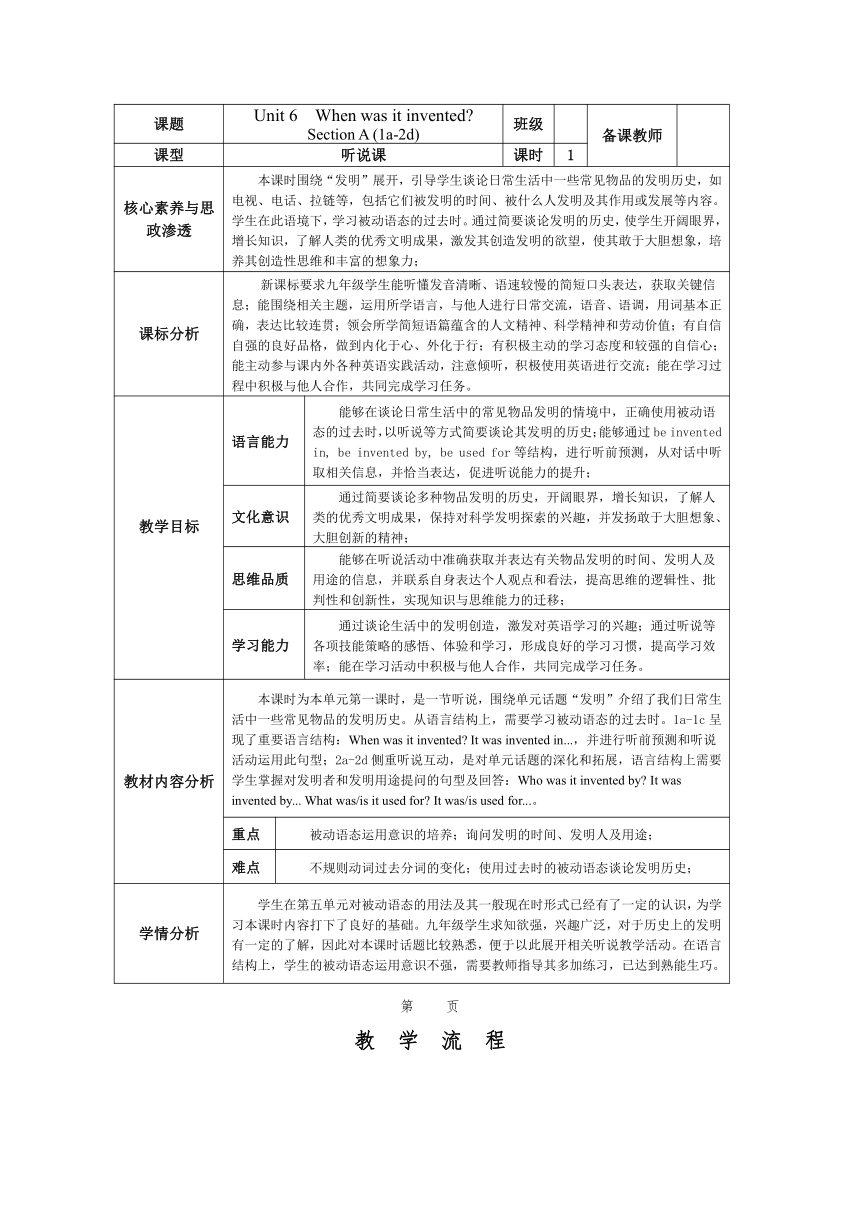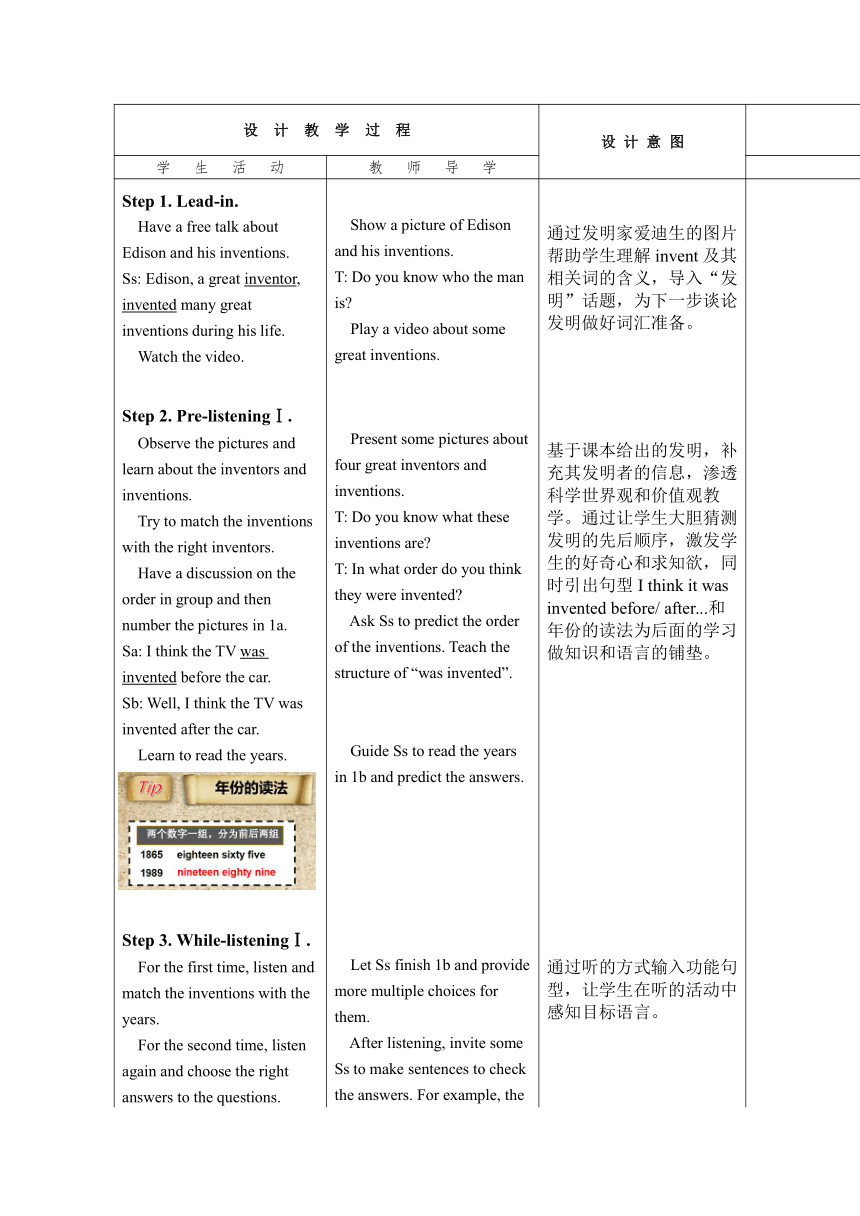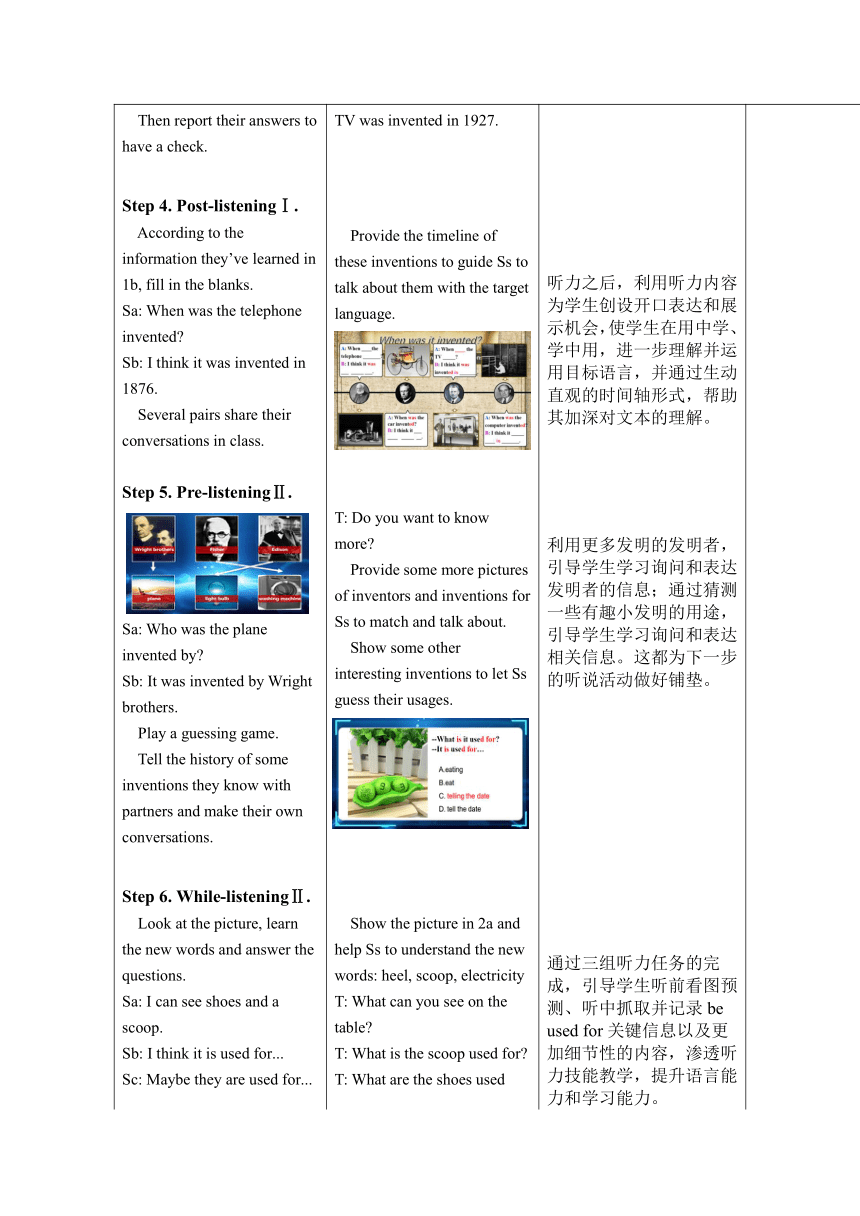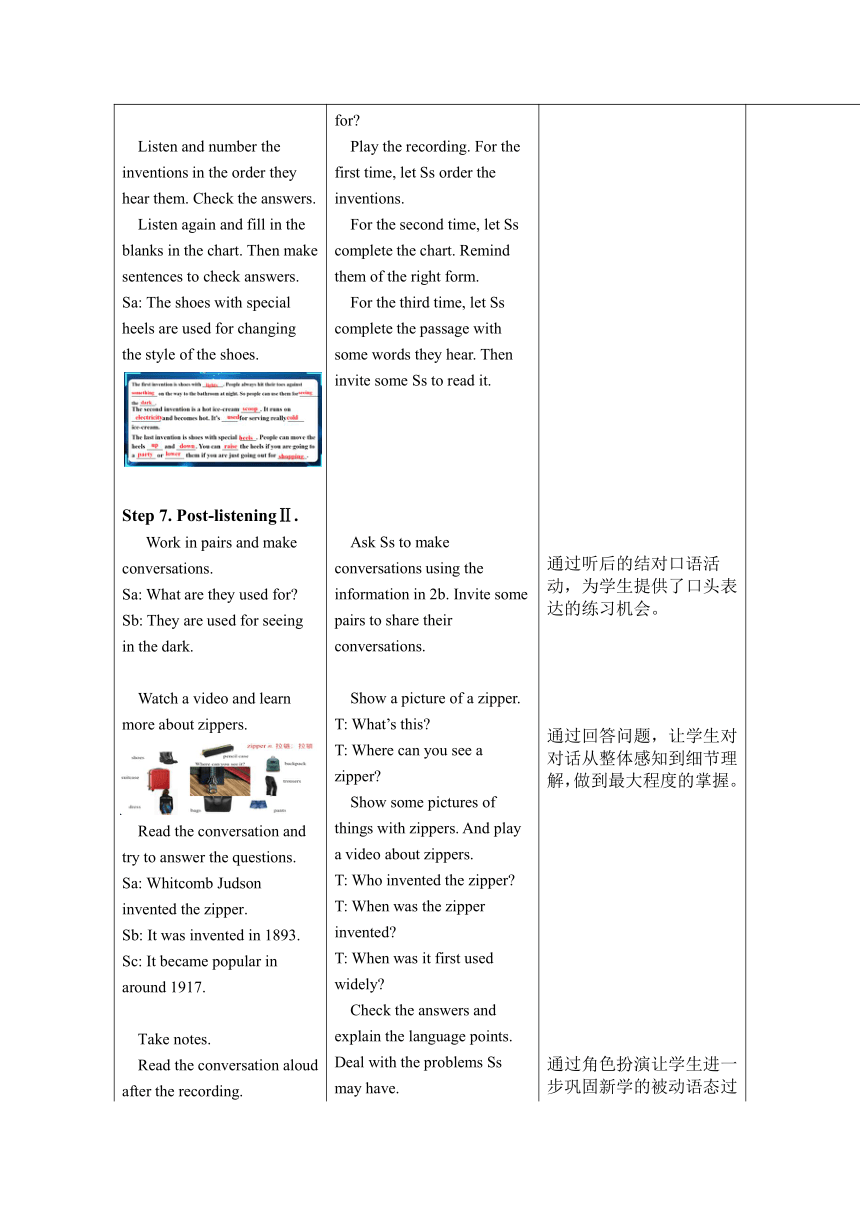【核心素养目标】Unit 6 When was it invented Section A (1a-2d)表格式教案
文档属性
| 名称 | 【核心素养目标】Unit 6 When was it invented Section A (1a-2d)表格式教案 |

|
|
| 格式 | docx | ||
| 文件大小 | 880.7KB | ||
| 资源类型 | 教案 | ||
| 版本资源 | 人教新目标(Go for it)版 | ||
| 科目 | 英语 | ||
| 更新时间 | 2024-09-24 10:48:29 | ||
图片预览




文档简介
课题 Unit 6 When was it invented Section A (1a-2d) 班级 备课教师
课型 听说课 课时 1
核心素养与思政渗透 本课时围绕“发明”展开,引导学生谈论日常生活中一些常见物品的发明历史,如电视、电话、拉链等,包括它们被发明的时间、被什么人发明及其作用或发展等内容。学生在此语境下,学习被动语态的过去时。通过简要谈论发明的历史,使学生开阔眼界,增长知识,了解人类的优秀文明成果,激发其创造发明的欲望,使其敢于大胆想象,培养其创造性思维和丰富的想象力;
课标分析 新课标要求九年级学生能听懂发音清晰、语速较慢的简短口头表达,获取关键信息;能围绕相关主题,运用所学语言,与他人进行日常交流,语音、语调,用词基本正确,表达比较连贯;领会所学简短语篇蕴含的人文精神、科学精神和劳动价值;有自信自强的良好品格,做到内化于心、外化于行;有积极主动的学习态度和较强的自信心;能主动参与课内外各种英语实践活动,注意倾听,积极使用英语进行交流;能在学习过程中积极与他人合作,共同完成学习任务。
教学目标 语言能力 能够在谈论日常生活中的常见物品发明的情境中,正确使用被动语态的过去时,以听说等方式简要谈论其发明的历史;能够通过be invented in, be invented by, be used for等结构,进行听前预测,从对话中听取相关信息,并恰当表达,促进听说能力的提升;
文化意识 通过简要谈论多种物品发明的历史,开阔眼界,增长知识,了解人类的优秀文明成果,保持对科学发明探索的兴趣,并发扬敢于大胆想象、大胆创新的精神;
思维品质 能够在听说活动中准确获取并表达有关物品发明的时间、发明人及用途的信息,并联系自身表达个人观点和看法,提高思维的逻辑性、批判性和创新性,实现知识与思维能力的迁移;
学习能力 通过谈论生活中的发明创造,激发对英语学习的兴趣;通过听说等各项技能策略的感悟、体验和学习,形成良好的学习习惯,提高学习效率;能在学习活动中积极与他人合作,共同完成学习任务。
教材内容分析 本课时为本单元第一课时,是一节听说,围绕单元话题“发明”介绍了我们日常生活中一些常见物品的发明历史。从语言结构上,需要学习被动语态的过去时。1a-1c呈现了重要语言结构:When was it invented It was invented in...,并进行听前预测和听说活动运用此句型;2a-2d侧重听说互动,是对单元话题的深化和拓展,语言结构上需要学生掌握对发明者和发明用途提问的句型及回答:Who was it invented by It was invented by... What was/is it used for It was/is used for...。
重点 被动语态运用意识的培养;询问发明的时间、发明人及用途;
难点 不规则动词过去分词的变化;使用过去时的被动语态谈论发明历史;
学情分析 学生在第五单元对被动语态的用法及其一般现在时形式已经有了一定的认识,为学习本课时内容打下了良好的基础。九年级学生求知欲强,兴趣广泛,对于历史上的发明有一定的了解,因此对本课时话题比较熟悉,便于以此展开相关听说教学活动。在语言结构上,学生的被动语态运用意识不强,需要教师指导其多加练习,已达到熟能生巧。
第 页
教 学 流 程
设 计 教 学 过 程 设 计 意 图
学 生 活 动 教 师 导 学
Step 1. Lead-in. Have a free talk about Edison and his inventions. Ss: Edison, a great inventor, invented many great inventions during his life. Watch the video. Step 2. Pre-listeningⅠ. Observe the pictures and learn about the inventors and inventions. Try to match the inventions with the right inventors. Have a discussion on the order in group and then number the pictures in 1a. Sa: I think the TV was invented before the car. Sb: Well, I think the TV was invented after the car. Learn to read the years. Step 3. While-listeningⅠ. For the first time, listen and match the inventions with the years. For the second time, listen again and choose the right answers to the questions. Then report their answers to have a check. Step 4. Post-listeningⅠ. According to the information they’ve learned in 1b, fill in the blanks. Sa: When was the telephone invented Sb: I think it was invented in 1876. Several pairs share their conversations in class. Step 5. Pre-listeningⅡ. Sa: Who was the plane invented by Sb: It was invented by Wright brothers. Play a guessing game. Tell the history of some inventions they know with partners and make their own conversations. Step 6. While-listeningⅡ. Look at the picture, learn the new words and answer the questions. Sa: I can see shoes and a scoop. Sb: I think it is used for... Sc: Maybe they are used for... Listen and number the inventions in the order they hear them. Check the answers. Listen again and fill in the blanks in the chart. Then make sentences to check answers. Sa: The shoes with special heels are used for changing the style of the shoes. Step 7. Post-listeningⅡ. Work in pairs and make conversations. Sa: What are they used for Sb: They are used for seeing in the dark. Watch a video and learn more about zippers. Read the conversation and try to answer the questions. Sa: Whitcomb Judson invented the zipper. Sb: It was invented in 1893. Sc: It became popular in around 1917. Take notes. Read the conversation aloud after the recording. Role-play the conversation in pairs. Then some pairs act their conversations out. Step 8. Summary. Show a picture of Edison and his inventions. T: Do you know who the man is Play a video about some great inventions. Present some pictures about four great inventors and inventions. T: Do you know what these inventions are T: In what order do you think they were invented Ask Ss to predict the order of the inventions. Teach the structure of “was invented”. Guide Ss to read the years in 1b and predict the answers. Let Ss finish 1b and provide more multiple choices for them. After listening, invite some Ss to make sentences to check the answers. For example, the TV was invented in 1927. Provide the timeline of these inventions to guide Ss to talk about them with the target language. T: Do you want to know more Provide some more pictures of inventors and inventions for Ss to match and talk about. Show some other interesting inventions to let Ss guess their usages. Show the picture in 2a and help Ss to understand the new words: heel, scoop, electricity T: What can you see on the table T: What is the scoop used for T: What are the shoes used for Play the recording. For the first time, let Ss order the inventions. For the second time, let Ss complete the chart. Remind them of the right form. For the third time, let Ss complete the passage with some words they hear. Then invite some Ss to read it. Ask Ss to make conversations using the information in 2b. Invite some pairs to share their conversations. Show a picture of a zipper. T: What’s this T: Where can you see a zipper Show some pictures of things with zippers. And play a video about zippers. T: Who invented the zipper T: When was the zipper invented T: When was it first used widely Check the answers and explain the language points. Deal with the problems Ss may have. Play the recording for Ss to listen and repeat. Have a summary of the useful expressions, sentences and function. 通过发明家爱迪生的图片帮助学生理解invent及其相关词的含义,导入“发明”话题,为下一步谈论发明做好词汇准备。 基于课本给出的发明,补充其发明者的信息,渗透科学世界观和价值观教学。通过让学生大胆猜测发明的先后顺序,激发学生的好奇心和求知欲,同时引出句型I think it was invented before/ after...和年份的读法为后面的学习做知识和语言的铺垫。 通过听的方式输入功能句型,让学生在听的活动中感知目标语言。 听力之后,利用听力内容为学生创设开口表达和展示机会,使学生在用中学、学中用,进一步理解并运用目标语言,并通过生动直观的时间轴形式,帮助其加深对文本的理解。 利用更多发明的发明者,引导学生学习询问和表达发明者的信息;通过猜测一些有趣小发明的用途,引导学生学习询问和表达相关信息。这都为下一步的听说活动做好铺垫。 通过三组听力任务的完成,引导学生听前看图预测、听中抓取并记录be used for关键信息以及更加细节性的内容,渗透听力技能教学,提升语言能力和学习能力。 通过听后的结对口语活动,为学生提供了口头表达的练习机会。 通过回答问题,让学生对对话从整体感知到细节理解,做到最大程度的掌握。 通过角色扮演让学生进一步巩固新学的被动语态过去时的句型,逐步引导学生思考并总结,培养学生乐于、善于表达的能力。 进行文化意识的渗透教育,激发其创造发明的欲望,使其敢于大胆想象、放手创造!
第 页
课 时 达 标 检 测
Ⅰ. 用词的适当形式填空。 E-payment service is now widely used in our __________ (day) life. His name was __________ (提到)several times at the meeting. — Thank you for doing that. — It’s a __________. (please) 4. What do you think is the most useful _________ (invent) of all Ⅱ. 单选题。 ( )5.— Would you please come to the dancing party with me tonight — ______. I suppose we shall have a wonderful night! A. Never mind B. Have a good time C. Not exactly D. With pleasure ( )6. — He always appears to _______. — That’s because he’s really knowledgeable and experienced. A. make an effort B. have a point C. pull together D. take place ( )7. — What did he say about his parents in his letter —He didn’t ______ his parents in the letter. A. admire B. notice C. mention D. miss ( )8. Safety glasses are used ______ protecting your eyes. A. from B. by C. to D. for Ⅲ. 句型转换。 The personal computer was invented in 1971. (对画线部分提问) ________ ________ the personal computer ________ The shoes with lights were invented by Julie Thompson. (对画线部分提问) ________ ________ the shoes with lights ________ ________ They are used for seeing in the dark. (对画线部分提问) ________ ________ they ________ ________ She was interviewed by the local TV station last week. (改为主动语态) The local TV station ________ ________ last week.
第 页
课 时 教 学 设 计 尾 页
板 书 设 计
Unit 6 When was it invented (Section A 1a-2d) ①--When was ... invented ——It was invented in ... ②—— Who was... invented by —— It was invented in ... ③-- What are they used for -- They are used for seeing in the dark.
作 业 设 计
Level A Search for other great or interesting inventions in our daily life on the Internet or in books. Make a invention card including your introduction and a picture of it. You should use “be invented in/ by...” “be used for...”.
Level B Write a short passage to introduce the inventions you’ve learned this lesson, including “when was it invented”, “who was it invented by” and “what was it used for”.
教 学 反 思
第 页
课型 听说课 课时 1
核心素养与思政渗透 本课时围绕“发明”展开,引导学生谈论日常生活中一些常见物品的发明历史,如电视、电话、拉链等,包括它们被发明的时间、被什么人发明及其作用或发展等内容。学生在此语境下,学习被动语态的过去时。通过简要谈论发明的历史,使学生开阔眼界,增长知识,了解人类的优秀文明成果,激发其创造发明的欲望,使其敢于大胆想象,培养其创造性思维和丰富的想象力;
课标分析 新课标要求九年级学生能听懂发音清晰、语速较慢的简短口头表达,获取关键信息;能围绕相关主题,运用所学语言,与他人进行日常交流,语音、语调,用词基本正确,表达比较连贯;领会所学简短语篇蕴含的人文精神、科学精神和劳动价值;有自信自强的良好品格,做到内化于心、外化于行;有积极主动的学习态度和较强的自信心;能主动参与课内外各种英语实践活动,注意倾听,积极使用英语进行交流;能在学习过程中积极与他人合作,共同完成学习任务。
教学目标 语言能力 能够在谈论日常生活中的常见物品发明的情境中,正确使用被动语态的过去时,以听说等方式简要谈论其发明的历史;能够通过be invented in, be invented by, be used for等结构,进行听前预测,从对话中听取相关信息,并恰当表达,促进听说能力的提升;
文化意识 通过简要谈论多种物品发明的历史,开阔眼界,增长知识,了解人类的优秀文明成果,保持对科学发明探索的兴趣,并发扬敢于大胆想象、大胆创新的精神;
思维品质 能够在听说活动中准确获取并表达有关物品发明的时间、发明人及用途的信息,并联系自身表达个人观点和看法,提高思维的逻辑性、批判性和创新性,实现知识与思维能力的迁移;
学习能力 通过谈论生活中的发明创造,激发对英语学习的兴趣;通过听说等各项技能策略的感悟、体验和学习,形成良好的学习习惯,提高学习效率;能在学习活动中积极与他人合作,共同完成学习任务。
教材内容分析 本课时为本单元第一课时,是一节听说,围绕单元话题“发明”介绍了我们日常生活中一些常见物品的发明历史。从语言结构上,需要学习被动语态的过去时。1a-1c呈现了重要语言结构:When was it invented It was invented in...,并进行听前预测和听说活动运用此句型;2a-2d侧重听说互动,是对单元话题的深化和拓展,语言结构上需要学生掌握对发明者和发明用途提问的句型及回答:Who was it invented by It was invented by... What was/is it used for It was/is used for...。
重点 被动语态运用意识的培养;询问发明的时间、发明人及用途;
难点 不规则动词过去分词的变化;使用过去时的被动语态谈论发明历史;
学情分析 学生在第五单元对被动语态的用法及其一般现在时形式已经有了一定的认识,为学习本课时内容打下了良好的基础。九年级学生求知欲强,兴趣广泛,对于历史上的发明有一定的了解,因此对本课时话题比较熟悉,便于以此展开相关听说教学活动。在语言结构上,学生的被动语态运用意识不强,需要教师指导其多加练习,已达到熟能生巧。
第 页
教 学 流 程
设 计 教 学 过 程 设 计 意 图
学 生 活 动 教 师 导 学
Step 1. Lead-in. Have a free talk about Edison and his inventions. Ss: Edison, a great inventor, invented many great inventions during his life. Watch the video. Step 2. Pre-listeningⅠ. Observe the pictures and learn about the inventors and inventions. Try to match the inventions with the right inventors. Have a discussion on the order in group and then number the pictures in 1a. Sa: I think the TV was invented before the car. Sb: Well, I think the TV was invented after the car. Learn to read the years. Step 3. While-listeningⅠ. For the first time, listen and match the inventions with the years. For the second time, listen again and choose the right answers to the questions. Then report their answers to have a check. Step 4. Post-listeningⅠ. According to the information they’ve learned in 1b, fill in the blanks. Sa: When was the telephone invented Sb: I think it was invented in 1876. Several pairs share their conversations in class. Step 5. Pre-listeningⅡ. Sa: Who was the plane invented by Sb: It was invented by Wright brothers. Play a guessing game. Tell the history of some inventions they know with partners and make their own conversations. Step 6. While-listeningⅡ. Look at the picture, learn the new words and answer the questions. Sa: I can see shoes and a scoop. Sb: I think it is used for... Sc: Maybe they are used for... Listen and number the inventions in the order they hear them. Check the answers. Listen again and fill in the blanks in the chart. Then make sentences to check answers. Sa: The shoes with special heels are used for changing the style of the shoes. Step 7. Post-listeningⅡ. Work in pairs and make conversations. Sa: What are they used for Sb: They are used for seeing in the dark. Watch a video and learn more about zippers. Read the conversation and try to answer the questions. Sa: Whitcomb Judson invented the zipper. Sb: It was invented in 1893. Sc: It became popular in around 1917. Take notes. Read the conversation aloud after the recording. Role-play the conversation in pairs. Then some pairs act their conversations out. Step 8. Summary. Show a picture of Edison and his inventions. T: Do you know who the man is Play a video about some great inventions. Present some pictures about four great inventors and inventions. T: Do you know what these inventions are T: In what order do you think they were invented Ask Ss to predict the order of the inventions. Teach the structure of “was invented”. Guide Ss to read the years in 1b and predict the answers. Let Ss finish 1b and provide more multiple choices for them. After listening, invite some Ss to make sentences to check the answers. For example, the TV was invented in 1927. Provide the timeline of these inventions to guide Ss to talk about them with the target language. T: Do you want to know more Provide some more pictures of inventors and inventions for Ss to match and talk about. Show some other interesting inventions to let Ss guess their usages. Show the picture in 2a and help Ss to understand the new words: heel, scoop, electricity T: What can you see on the table T: What is the scoop used for T: What are the shoes used for Play the recording. For the first time, let Ss order the inventions. For the second time, let Ss complete the chart. Remind them of the right form. For the third time, let Ss complete the passage with some words they hear. Then invite some Ss to read it. Ask Ss to make conversations using the information in 2b. Invite some pairs to share their conversations. Show a picture of a zipper. T: What’s this T: Where can you see a zipper Show some pictures of things with zippers. And play a video about zippers. T: Who invented the zipper T: When was the zipper invented T: When was it first used widely Check the answers and explain the language points. Deal with the problems Ss may have. Play the recording for Ss to listen and repeat. Have a summary of the useful expressions, sentences and function. 通过发明家爱迪生的图片帮助学生理解invent及其相关词的含义,导入“发明”话题,为下一步谈论发明做好词汇准备。 基于课本给出的发明,补充其发明者的信息,渗透科学世界观和价值观教学。通过让学生大胆猜测发明的先后顺序,激发学生的好奇心和求知欲,同时引出句型I think it was invented before/ after...和年份的读法为后面的学习做知识和语言的铺垫。 通过听的方式输入功能句型,让学生在听的活动中感知目标语言。 听力之后,利用听力内容为学生创设开口表达和展示机会,使学生在用中学、学中用,进一步理解并运用目标语言,并通过生动直观的时间轴形式,帮助其加深对文本的理解。 利用更多发明的发明者,引导学生学习询问和表达发明者的信息;通过猜测一些有趣小发明的用途,引导学生学习询问和表达相关信息。这都为下一步的听说活动做好铺垫。 通过三组听力任务的完成,引导学生听前看图预测、听中抓取并记录be used for关键信息以及更加细节性的内容,渗透听力技能教学,提升语言能力和学习能力。 通过听后的结对口语活动,为学生提供了口头表达的练习机会。 通过回答问题,让学生对对话从整体感知到细节理解,做到最大程度的掌握。 通过角色扮演让学生进一步巩固新学的被动语态过去时的句型,逐步引导学生思考并总结,培养学生乐于、善于表达的能力。 进行文化意识的渗透教育,激发其创造发明的欲望,使其敢于大胆想象、放手创造!
第 页
课 时 达 标 检 测
Ⅰ. 用词的适当形式填空。 E-payment service is now widely used in our __________ (day) life. His name was __________ (提到)several times at the meeting. — Thank you for doing that. — It’s a __________. (please) 4. What do you think is the most useful _________ (invent) of all Ⅱ. 单选题。 ( )5.— Would you please come to the dancing party with me tonight — ______. I suppose we shall have a wonderful night! A. Never mind B. Have a good time C. Not exactly D. With pleasure ( )6. — He always appears to _______. — That’s because he’s really knowledgeable and experienced. A. make an effort B. have a point C. pull together D. take place ( )7. — What did he say about his parents in his letter —He didn’t ______ his parents in the letter. A. admire B. notice C. mention D. miss ( )8. Safety glasses are used ______ protecting your eyes. A. from B. by C. to D. for Ⅲ. 句型转换。 The personal computer was invented in 1971. (对画线部分提问) ________ ________ the personal computer ________ The shoes with lights were invented by Julie Thompson. (对画线部分提问) ________ ________ the shoes with lights ________ ________ They are used for seeing in the dark. (对画线部分提问) ________ ________ they ________ ________ She was interviewed by the local TV station last week. (改为主动语态) The local TV station ________ ________ last week.
第 页
课 时 教 学 设 计 尾 页
板 书 设 计
Unit 6 When was it invented (Section A 1a-2d) ①--When was ... invented ——It was invented in ... ②—— Who was... invented by —— It was invented in ... ③-- What are they used for -- They are used for seeing in the dark.
作 业 设 计
Level A Search for other great or interesting inventions in our daily life on the Internet or in books. Make a invention card including your introduction and a picture of it. You should use “be invented in/ by...” “be used for...”.
Level B Write a short passage to introduce the inventions you’ve learned this lesson, including “when was it invented”, “who was it invented by” and “what was it used for”.
教 学 反 思
第 页
同课章节目录
- Unit 1 How can we become good learners.
- Section A
- Section B
- Unit 2 I think that mooncakes are delicious!
- Section A
- Section B
- Unit 3 Could you please tell me where the restroom
- Section A
- Section B
- Unit 4 I used to be afraid of the dark.
- Section A
- Section B
- Unit 5 What are the shirts made of?
- Section A
- Section B
- Review of Units 1-5
- Unit 6 When was it invented?
- Section A
- Section B
- Unit 7 Teenagers should be allowed to choose their
- Section A
- Section B
- Unit 8 It must belong to Carla.
- Section A
- Section B
- Unit 9 I like music that I can dance to.
- Section A
- Section B
- Unit 10 You're supposed to shake hands.
- Section A
- Section B
- Review of Units 6-10
- Unit 11 Sad movies make me cry.
- Section A
- Section B
- Unit 12 Life is full of the unexpected
- Section A
- Section B
- Unit 13 We're trying to save the earth!
- Section A
- Section B
- Unit 14 I remember meeting all of you in Grade 7.
- Section A
- Section B
- Review of Units 11-14
